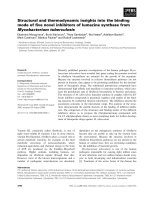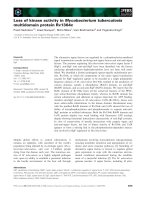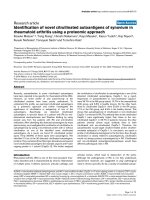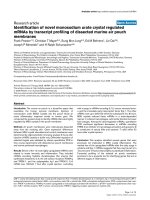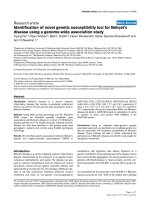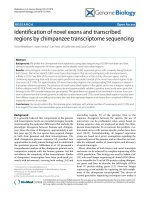Identification of novel inhibitors against mycobacterium tuberculosis l aspartate a decarboxyalse
Bạn đang xem bản rút gọn của tài liệu. Xem và tải ngay bản đầy đủ của tài liệu tại đây (4.56 MB, 117 trang )
IDENTIFICATION OF NOVEL INHIBITORS AGAINST
MYCOBACTERIUM TUBERCULOSIS
L-ASPARTATE α- DECARBOXYALSE
REETU SHARMA
THESIS SUBMITTED FOR THE DEGREE OF
DOCTOR OF PHILOSOPHY
DEPARTMENT OF BIOLOGICAL SCIENCES
NATIONAL UNIVERSITY OF SINGAPORE
2012
IDENTIFICATION OF NOVEL INHIBITORS AGAINST
MYCOBACTERIUM TUBERCULOSIS
L-ASPARTATE α- DECARBOXYALSE
REETU SHARMA
(M.Sc. Biotechnology)
A THESIS SUBMITTED FOR THE DEGREE OF
DOCTOR OF PHILOSOPHY
DEPARTMENT OF BIOLOGICAL SCIENCES
NATIONAL UNIVERSITY OF SINGAPORE
2012
Dedicated to
My teachers, family and friends
i
ACKNOWLEDGMENT
I am thankful to my supervisor Prof. Kunchithapadam Swaminathan for his
constant support and guidance at every step of the project. I sincerely appreciate his
ready accessibility and availability. I am also thankful to him for providing me an
opportunity to prove my acquired skills in research.
I convey my special thanks to Prof. Antonius M.J. VanDongen, DUKE-NUS
Graduate Medical School for his collaboration on the chemo-informatics based study.
I am thankful to Prof. Werner Nau, Jacobs University, Germany for allowing
me to work in his lab and his guidance. I extend special thanks to Ms. Mara Florea for
her help in developing an NMR based enzyme kinetic assay. I cannot forget the help I
received from Dr. Maik Jacob, Hamdy El Sheshtawy, Roy D’Souza, Vanya Uzunova,
Indrajit Ghosh, Amir Norouzy, Garima Ghale, Khaleel Assaf, Alexandra Irina Lazar
and Sweccha Joshi in his lab.
This is a great opportunity to say thanks to the past and present lab members
of Lab4 and 5. It was a great experience and pleasure to work with Kanmani,
FengXia, Umar, Roopa, Deepthi, Anu, Madhuri, and Pavithra. Also, good friendship
with them provided me a constant support throughout my Ph.D. tenture. Thanks to
everyone in the structural biology corridor, including Shveta Tivari, Suguna,
Thangavelu, Manjeet, Abhilash, Priyanka, Digant and Sharath. I welcome Divya, our
new lab member and wish her the best of luck.
I want to thank NUS for my research scholarship, which supported my four
years of stay in Singapore and the short term attachment visit in Germany and thus
helped me pursue my research.
ii
Last but not the least, I am thankful to my parents and my brother Sachin for
his support and encouragement, which was of great help to overcome the work
pressure doing my Ph.D.
iii
TABLE OF CONTENTS
Page
Acknowledgement i
Table of contents iii
Summary v
List of abbreviations vi
List of figures viii
List of table xi
List of publications xii
Chapter 1
1.1 Tuberculosis 1
1.2 Infection with tuberculosis 1
1.3 Mtb inside macrophage: latent phase of the disease 2
1.4 Control measures for tuberculosis 4
1.5 L-aspartate α- decarboxylase 6
1.6 Mechanism of ADC catalyzing the reaction 9
1.7 Drug Development 12
Chapter 2
2.1 Modeling of processed MtbADC structure 21
2.2 Structure based virtual screening 21
2.3 Non cross-reactivity with human pyruvoyl-dependent enzymes 27
2.4 Preparation of E. coli BL21 (DE3) competent cells 27
2.5 Protein expression and purification 28
2.6 Inhibitor preparation 29
2.7 Nuclear Magnetic Resonance spectroscopy 30
iv
2.8 In vitro activity against M. tuberculosis 31
Chapter 3
3.1 Structural overview of L-asparate α-decarboxylase 33
3.2 Selection of inhibitors 34
3.3 In silico validation 46
3.4 Expression and purification of ADC 52
3.5 In vitro activity against Mycobacterium tuberculosis 72
Chapter 4
4.1. Discussion 75
Chapter 5
5.1. Future Directions 84
References 89
Appendix
v
SUMMARY
L-Aspartate α-decarboxylase (ADC) belongs to a class of pyruvoyl dependent
enzymes and catalyzes the conversion of aspartate to β-alanine in the pantothenate
pathway, which is critical for the growth of several micro-organisms, including
Mycobacterium tuberculosis (Mtb). Its presence only in micro-organisms, fungi and
plants and its absence in animals, particularly human, make it a promising drug target.
Cleaved Mycobacterium tuberculosis L-Aspartate α-decarboxylase (MtbADC)
structure was modelled and based on chemoinformatics drug-design approach,
potential drug-like inhibitors against MtbADC were identified, following which we
employed proton Nuclear Magnetic Resonance (NMR) based assay to systematically
screen the inhibitors that we have earlier identified from the Maybridge, National
Cancer Institute (NCI) and Food and Drug Administration (FDA) approved drugs
databases and those reported earlier in the literature(Sharma et al., 2012a). The
concentrations of substrate and product in the reaction were quantified with time and
the percentage of conversion and a relative inhibition constant (k
rel
) were used to
compare the inhibitory properties of the previously known molecules: oxaloacetate,
DL-threo-β-hydroxy aspartate, L-glutamate and L-cysteic acid with relative inhibition
constant k
rel
values of 0, 0.36, 0.40 and 0.40, respectively and the newly identified
molecules: D-tartaric acid, L-tartaric acid and 2,4-dihydroxypyrimidine-5-carboxylic
acid with k
rel
values of 0.36, 0.38 and 0.54, respectively(Sharma et al., 2012b). Novel
inhibitors were further tested for their inhibitory activity against Mtb culture. These
molecules could serve as potential building blocks for developing better therapeutic
agents.
vi
LIST OF ABBREVIATIONS
TB Tuberculosis
WHO World Health Organization
HIV Human immunodeficiency virus
Mtb Mycobacterium tuberculosis
BCG Bacillus Calmette-Guérin
PZA Pyrazinamide
DOT Directly Observed Therapy
MDR Multiple Drug Resistant
ADC L-Aspartate α- decarboxylase
CoA Coenzyme A
E. coli Escherichia coli
NCI National Cancer Institute
FDA Food and Drug Administration
NMR Nuclear Magnetic Resonance
PK Pharmacokinetic
ADME Absorption/Distribution/Metabolism/Excretion
MTD Maximum tolerance dose
RMSD Root mean square deviation
VDW Van der Waals
HTVS High throughput virtual screening
G-scores Glide scores
SAM S-adenosylmethionine
vii
LB Luria Broth
DNA Deoxyribonucleic acid
DMSO Dimethyl sulfoxide
MIC Minimum Inhibitory Concentration
SDS Sodium dodecyl sulfate
PAGE Polyacrylamide gel electrophoresis
ESMS Electrospray ionization mass spectra
HPLC High performance liquid chromatography
viii
LIST OF FIGURES
Page
Figure 1.1 Schematic diagram of Mycobacterium tuberculosis infection. 2
Figure 1.2 Pantothenate and CoA biosynthesis pathway. 7
Figure 1.3 Proposed mechanism of self-cleavage of ADC protein. 9
Figure 1.4 Ribbon representation of ADC. 10
Figure 1.5 Proposed catalytic mechanism of ADC catalyzing the 11
conversion of aspartate to β-alanine.
Figure 1.6 Schematic diagram showing the stages involved in 13
drug development.
Figure 1.7 Screening for novel inhibitors by molecular docking. 15
Figure 1.8 The flow chart of the process used to identify inhibitors 19
against MtbADC.
Figure 2.1 Preparation of protein by the use of Protein Preparation 22
wizard in Schrödinger suite.
Figure 2.2 Ligand preparation by the use of Ligprep 23
panel in Schrödinger suite.
Figure 2.3 Receptor tab of Receptor Grid generation 24
panel in Schrödinger suite.
Figure 2.4 Site tab in Receptor Grid generation 25
panel of Schrödinger suite.
Figure 2.5 Ligand docking to receptor by ligand docking 26
panel of Glide in Schrödinger suite.
Figure 3.1 Conserved functional residues of ADCs that bind to substrate. 33
Figure 3.2 Active site residues of SAM decarboxylase. 35
ix
Figure 3.3 Chemical structures of the eight lead molecules. 37
Figure 3.4 Binding poses of the identified eight lead molecules 47
with MtbADC.
Figure 3.5 Fumarate binding in ADC. 48
Figure 3.6 Structures of known inhibitors against ADC. 49
Figure 3.7 Binding poses of known inhibitors/ligands. 50
Figure 3.8 Ligands docked to monomeric MtbADC. 51
Figure 3.9 Summary of the drug design approach. 52
Figure 3.10 Expression and purification of Mtb panD in E. coli. 53
Figure 3.11 Gel filtration profile of ADC-his tagged in superdex-200 54
column.
Figure 3.12 Electrospray ionization mass spectra of Mtb 54
cleaved aspartate decarboxylase.
Figure 3.13 NMR spectra of the time study of aspartate decarboxylation. 56
Figure 3.14 Enzyme kinetics of the decarboxylation reaction. 57
Figure 3.15 Structure of reported molecules tested for inhibitory activity. 58
Figure 3.16 NMR spectra in presence of oxaloacetate (K1). 58
Figure 3.17 NMR spectra in presence of β-hydroxyaspartate (K2). 59
Figure 3.18 NMR spectra in presence of L-glutamate (K3). 60
Figure 3.19 NMR spectra in presence of L-cysteic acid (K4). 60
Figure 3.20 NMR spectra in presence of succinate (K5). 61
Figure 3.21 NMR spectra in presence of L-serine (K6). 62
Figure 3.22 NMR spectra in presence of D-serine (K7). 62
Figure 3.23 Structure of novel potential inhibitors identified by in silico 64
studies to be validated using proton NMR.
x
Figure 3.24 NMR spectra in presence of D-tartrate (I1). 65
Figure 3.25 Enzyme kinetics of the decarboxylation reaction 66
in presence of D-tartrate after 30 min of reaction.
Figure 3.26 NMR spectra in presence of L-tartrate (I2). 67
Figure 3.27 NMR spectra in presence of 68
2,4-dihydroxypyrimidine-5-carboxylate (I3).
Figure 3.28 NMR spectra in presence of D-tagatose (I4) . 68
Figure 3.29 NMR spectra in presence of 69
(4S)-1,3-thiazolidin-3-ium-4-carboxylate (I5).
Figure 3.30 NMR spectra in presence of á-D-arabinopyranose (I6). 70
Figure 3.31 NMR spectra in presence of 71
1,2-dihydropyrazolo[3,4-d]pyrimidin-4-one (I7).
Figure 5.1 Fluorescence based assay. 86
xi
LIST OF TABLES
Page
Table 1.1 Phases of clinical trials. 17
Table 3.1 The 28 ligand hits from the Maybridge, NCI and FDA 38
databases which interact with at least one of the conserved
functional residues of MtbADC residues involved in substrate
binding and their glide score (kcal/mol).
Table 3.2 Pharmacokinetic properties of the 28 ligands. 41
Table 3.3 Assessment of drug-like properties of the lead molecules 44
and fumarate as verified by Qikprop (Schrödinger 9.0).
Table 3.4 The inhibition properties of selected known (coded with ‘K’) 63
Inhibitors against Mycobacterium tuberculosis L-aspartate α-
decarboxylase (MtbADC).
Table 3.5 The inhibition properties of newly identified (coded with ‘I’) 71
lead molecules against (MtbADC).
Table 3.6 In vitro activity against Mycobacterium tuberculosis. 73
xii
PUBLICATIONS
Singh NS, Shao N, McLean JR, Sevugan M, Ren L, Chew TG, Bimbo A, Sharma R,
Tang X, Gould KL and Balasubramanian MK (2011). SIN-inhibitory phosphatase
complex promotes cdc11p dephosphorylation and propagates SIN asymmetry in
fission yeast. Current Biology, 21, 1968-1978.
Sharma R, Kothapalli R, Dongen AMJV and Swaminathan K. (2012).
Chemoinformatic identification of novel inhibitors against Mycobacterium
tuberculosis (Mtb) L-aspartate α-decarboxylase. PLoS ONE 7, e33521.
Sharma R, Florea M, Nau WM and Swaminathan K. (2012). Validation of Drug-Like
Inhibitors against Mycobacterium tuberculosis L-aspartate-α-decarboxylase using
Nuclear Magnetic Resonance (1H NMR). PLoS ONE, 7, e45947.
xiii
CHAPTER 1
INTRODUCTION
1
CHAPTER 1. INTRODUCTION
1.1 TUBERCULOSIS
Tuberculosis (TB) is caused by the respiratory pathogen Mycobacterium
tuberculosis. The primary organ affected by the bacterium is the lungs. However, TB
can also affect the central nervous system, lymphatic system, circulatory system,
genitourinary system, bones, joints and the skin (Raviglione and Brien, 2004). The
disease continues to be a leading cause of death worldwide (WHO, 2011).
Approximately one-third of the world population is infected with Mtb, at an estimated
rate of about two million people annually. The WHO 2011 report estimates 8.8
million incidents of TB and 1.1 million HIV-negative deaths and 0.35 million HIV-
positive deaths (Dye and Williams, 2010; WHO, 2011).
Not every infected individual will immediately develop the disease and the
majority has asymptomatic or latent disease. The disease will develop in
approximately one in ten asymptomatic patients. If left untreated, TB could be lethal
in more than 50% of patients. According to Kaufmann and McMichael, about two
million people succumb to the disease annually (Kaufmann and McMichael, 2005).
These data indicate the need to develop effective therapeutics against the bacterium.
1.2 INFECTION WITH TUBERCULOSIS
Inhaled bacteria in the tubercle are engulfed by macrophages and dentritic
cells. Some of the dentriticc cells migrate to lymph nodes where they activate T cells
and induce containment in small granulomatous lesions of the lung but may not
completely eradicate the microbe. Approximately 90% of the infected individual does
2
not suffer from clinical disease and the bacterium remains in the latent form inside the
macrophage. The process of infection is slow and hence disease outbreak gets delayed
(Kaufmann, 2001). According to Manabe and Bishai, reactivation of existing foci is
responsible for tuberculosis in adults, rather than as a direct outcome of primary
infection (Manabe and Bishai, 2000) (Fig. 1.1).
Figure 1.1. Schematic diagram of Mycobacterium tuberculosis
infection. Modified from Kaufmann, 2004.
1.3. MTB INSIDE MACROPHAGE: LATENT PHASE OF THE DISEASE
Mtb is an intracellular pathogen which has developed sophisticated
mechanisms of survival within host macrophages, including preventing recognition of
3
infected macrophages by T cells by inhibiting MHC class II processing and
presentation, evading macrophage killing mechanisms, such as those mediated by
reactive nitrogen intermediates and phagolysosome fusion (Flynn et al. 2003).
Macrophages offer the bacterium a preferred habitat (Schaible et al., 1999). If Mtb
interacts with the constant regions of immunoglobulin receptors (FcRs) and toll-like
receptors, host defence mechanisms will be stimulated, whereas interactions with
complement receptors promote survival of mycobacterium (Armstrong and Hart,
1975; Brightbill, 1999; Schorey, 1997). In the endosome, iron is available to Mtb for
its survival (Andrews, 2000; Lounis et al., 2001; Schaible et al., 1999) (Lounis et al.,
2001).The bacterium even survives the harsh environment of the phagosome, which is
generally detrimental to most microbes . Activation with interferon-γ promotes the
maturation of phagosomes, which stimulates anti-mycobacterial mechanisms in
macrophages such as reactive oxygen intermediates (ROI) and reactive nitrogen
intermediates (RNI)(Schaible et al., 1999) . RNI plays an important role in the control
of M. tuberculosis (Nathan and Shiloh, 2000). However, M. tuberculosis is not fully
eradicated even in IFN-γ activated macrophages.
In the dormant stage, the metabolic activity of Mtb gets reduced and facilitates
its survival under the conditions of nutrient and oxygen deprivation. Mtb goes into the
latent stage where it persists without producing any disease. Nevertheless, the risk of
disease outbreak at a later time remains. McKinney et al. have indicated that
mycobacteria switch to lipid catabolism and nitrate respiration to ensure their survival
(McKinney et al., 2000). Lipids are abundant in the caseous detritus of granulomas,
providing a rich source of nutrients during persistence. In less than 10% cases such as
immunosuppressive individual, for example HIV infected, newly born or aged person,
primary infection transforms into disease. Under the disease condition, cavity lesions
4
develop and the number of bacteria increases in caeseous detritus. The patient
becomes infectious when cavitation is reached (Kaufmann, 2000; Kaufmann, 2004)
(Fig. 1.3).
1.4 CONTROL MEASURES FOR TUBERCULOSIS
Acid-fast staining of sputum and skin testing with tuberculin (using purified
protein derivative of Mtb, PPD), developed by Robert Koch in 1882 and 1890,
respectively, are the two techniques usually employed for the diagnosis of
tuberculosis. Treatment measures include the administration of Bacillus Calmette
Guerin (BCG) as a vaccine and the use of anti-microbial drugs. The BCG vaccine was
developed jointly by Albert Calmette and Camille Guérin in the 1910s. New
molecular techniques, which detect T cell reactivity to Mtb specific-antigens not
found in BCG, help to identify latently infected healthy TB contacts for targeting
prophylactic treatment (Mazurek 2003).
Streptomycin, discovered by Waksman in 1943, was the first drug used to treat
TB (Schatz and Waksman, 1944). It interacts with the small 30S subunit of the
ribosome and perturbs the biosynthesis of proteins (Carter et al., 2000; Garvin et al.,
1974). It was followed later by isoniazid (INH) (Bernstein et al., 1952), rifampicin,
pyrazinamide and ethambutol, but all these drugs have significant side-effects (CDC,
2003). Rifampicin, one of the most potent drugs against TB, used even now, has been
suggested to act by inhibiting the mycolic acid biosynthesis, an essential component
of mycobacterial cell wall (Timmins and Deretic, 2006; Winder and Collins, 1970).
Pyrazinamide (PZA) was discovered as a potential TB drug in 1952 (Malone
et al., 1952). Despite similarityin structure, isoniazid and pyrazinamide are different
in their mechanism of action. Pyrazinamide activity causes intake of proton and
5
dysfunction of the pH balance of mycobacteria (Zhang and Mitchison, 2003; Zhang et
al., 2003). Shi et al. has shown that Pyrazinamide inhibits translation in
Mycobacterium tuberculosis. It targets the essential ribosomal protein S1, which is
involved in the ribosome-sparing process of translation (Shi et al., 2011). Ethambutol,
discovered in 1961 (Thomas et al., 1961), affects the cell wall by inhibiting
polymerization of arabinogalactane and lipoarabinomannane (Belanger et al., 1996).
Treatment against the disease has shown to be significantly improved when
the drugs are combined in specific quantities and administered to the patient. WHO
recommends the directly observed therapy (DOT), a combination of isoniazid,
rifampin, ethambutol and pyrazinamide for 6 months and TB patients are observed by
medical personnel while taking their daily dose, mainly to monitor and improve
patient adherence with the therapy (WHO, 2008).
In recent decades, the bacterium has shown to develop resistance against
several available drugs. To treat multiple drug resistant TB, WHO has recommended
the use of prothionamide and ethionamide (discovered in 1956, (Libermann et al.,
1956), which target the mycolic acids biosynthesis through the inhibition of InhA
(Banerjee et al., 1994). D-cycloserine, discovered in 1969, is another cell wall
synthesis inhibitor (David et al., 1969) and triggers peptidoglycan synthesis through
D-alanine racemase and D-alanine ligase inhibition (Cáceres et al., 1997; Feng and
Barletta, 2003).
The emergence of multiple drug resistant tuberculosis (MDR-TB) and
extensively resistant tuberculosis (XDR-TB) has increased the failure rate and cost of
treatment (Glynn et al., 2002; Reece and Kaufmann, 2008). This has prompted
further interest in the development of more effective TB treatment strategies.
6
1.5 L-ASPARTATE α-DECARBOXYLASE
L-Aspartate α- decarboxylase (ADC, EC 4.1.1.11), encoded by the panD gene,
is a lyase and catalyzes the decarboxylation of aspartate to β-alanine, which is
essential for D-pantothenate formation (Fig. 1.2). Mutants of the panD gene are
defective in β-alanine biosynthesis (Cronan, 1980). β-alanine and D-pantoate
condense to form pantothenate, a precursor of coenzyme A (CoA), which functions as
an acyl carrier in fatty acid metabolism and provides the 4΄- phosphopantetheine
prosthetic group in fatty acid biosynthesis, an essential need for the growth of several
micro-organisms, including Mycobacterium tuberculosis (Mtb) (Sassetti et al., 2003;
Spry et al., 2008), the causative bacterial agent of tuberculosis (Tb).
The distinctive lipid rich cell wall of Mtb is responsible for the unusually low
permeability, virulence and resistance to therapeutic agents (Cox et al., 1999; Daffé
and Draper, 1997). At the heart of the fight against tuberculosis lies its cell wall, a
multilayered structure adorned with a number of lipo-glycans that protect the
bacterium in antimicrobial defense against environmental stresses and treatment.
Consequently, the metabolism and biosynthesis of lipids and lipo-glycans play a
pivotal role in the intracellular survival and persistence of Mtb. Any impediment in
the pantothenate pathway will therefore affect the survival of the bacterium. As Mtb is
notorious to develop resistance towards drugs, progress in the treatment of
tuberculosis will require us to identify new targets in pathways critical for the
sustenance of Mtb, and to develop new drugs selectively inhibiting these targets so as
to minimize drug resistance and potential side effects (Glickman et al., 2000;
Karakousis, 2009). Since pantothenate is synthesized only in microorganisms, fungi
7
Figure 1.2. Pantothenate and CoA biosynthesis pathway. L-
Aspartate α-decarboxylase (ADC) catalyzes the decarboxylation of L-
aspartate to β-alanine.
and plants, but not in humans, the enzymes that are involved in this biosynthetic
pathway qualify to be potential targets for antibacterial and antifungal agents
(Jackowski, 1996). The absence of this pathway in humans ensures that any inhibitor
or drug against ADC would have low toxicity in patients. In particular, the chance of
8
side effects in a long term treatment procedure will be minimal. Moreover, the
presence of the ADC gene in only one copy in the Mtb genome further enhances its
importance as a suitable drug target.
MtbADC (139 amino acids) undergoes autocatalyzed cleavage between Gly24
and Ser25, where the serine is modified to a pyruvoyl group, resulting in the
formation of approximately 13 kDa α-chain containing the N-terminal pyruvoyl
group and nearly 2.7 kDa β-chain. The cleavage reaction involves the formation of an
ester intermediate by an initial N-O acyl rearrangement (Shao et al., 1996; van Poelje
and Snell, 1990). N-terminal dehydroalanine is formed after elimination of the ester,
which is hydrolyzed to form the alpha subunit with an N-terminal pyruvoyl group
(Albert et al., 1998) (Fig. 1.3). The self cleavage can be thermally promoted (Ramjee
et al., 1997). This processed α form is necessary for the conversion of aspartate to β-
alanine (Ramjee et al., 1997) and the mutation S25A makes the protein uncleavable
and inactive (Kennedy and J., 2004).
So far, crystal structures have been determined for unprocessed (uncleaved)
ADC from E. coli (PDB id: 1PPY) (Schmitzberger et al., 2003), Mtb (2C45) (Gopalan
et al., 2006), and processed ADC from E. coli (1AW8) (Albert et al., 1998),
Francisella tularensis (3OUG), Campylobacter jejuni (3PLX), Thermus thermophilus
ADC (TthADC) (1VC3), TthADC, complexed with substrate analog fumarate
(2EEO), Helicobacter pylori ADC (HpyADC) (1UHD) (Lee and Suh, 2004) and
HpyADC, complexed with substrate analog isoasparagine (1UHE) (Lee and Suh,
2004). The ADC protein folds into a double-ψ β-barrel structure. It forms a
homotetramer (Gopalan et al., 2006) (Fig. 1.4 A and Fig. 1.4C) and the active site is
shown to be at the interface of a dimer of processed ADC (Lee and Suh, 2004) (
Fig.1.4 B).
9
HN
H
N
N
H
O
O
HO
HN
H
N
O
O O
H NH
2
HN
H
N
O
O O
NH
2
H
N
O
HN
OH
O
Gly 24 - Ser 25
NH
2
H
N
O
O
alpha-subunit with pyruvoyl group at N-terminus
( 13206 Da)
beta-subunit
(2744 Da)
Uncleaved ADC
(15707 Da)
Figure 1.3. Proposed mechanism of self-cleavage of ADC protein
Modified from Albert et al., 1998.
1.6 Mechanism of ADC catalyzing the reaction.
The first step of the catalytic reaction involves a nucleophilic attack of the
primary hydroxyl group of Ser25 in the vicinity of the Gly24 - Ser25 peptide bond.
Tyr58 protonates the primary amine formed after the formation of the ester. In the
second step, the ester intermediate is broken down. Lee and Suh (Lee and Suh, 2004)
have proposed the mechanism of action of ADC by analyzing co-crystallization of the
substrate analog isoasparagine with the ADC protein where the pyruvoyl group plays
an important role as a cofactor. Prior to decarboxylation a Schiff base intermediate is
formed at the active site of subunits A and B. The nitrogen atom of ammonium group
of Lys9*, N atom of His11*, hydroxyl group oxygen of Tyr58 are in close proximity
to the active site at distance of 2.7, 4.5 and 3.3 Å, respectively.
